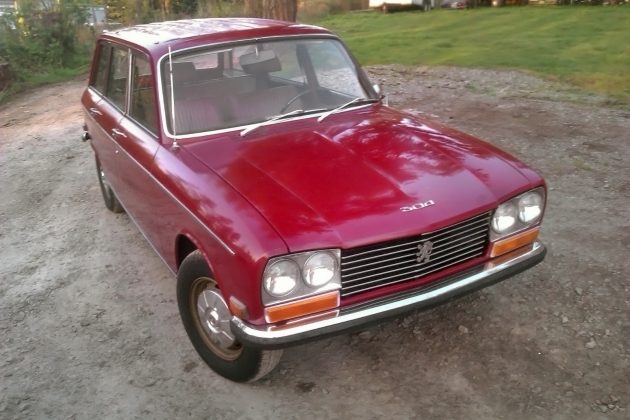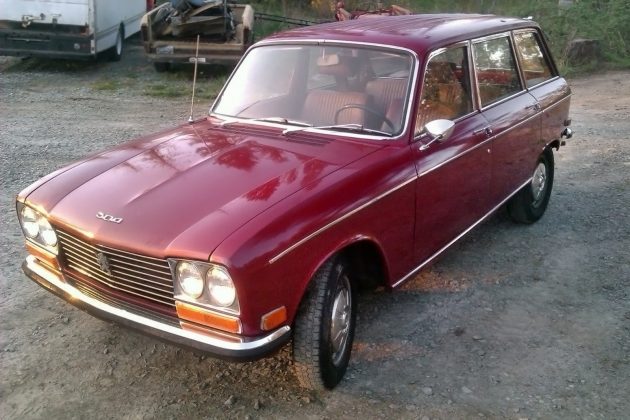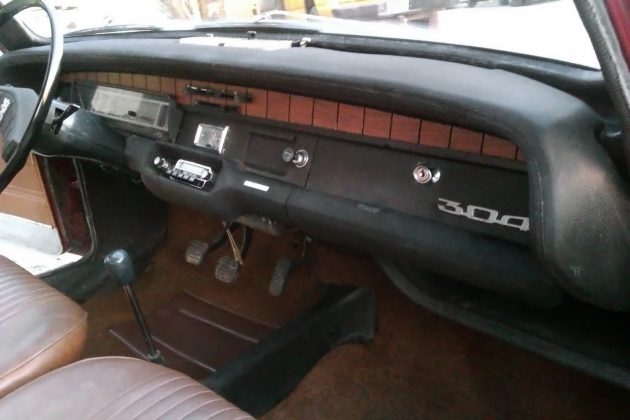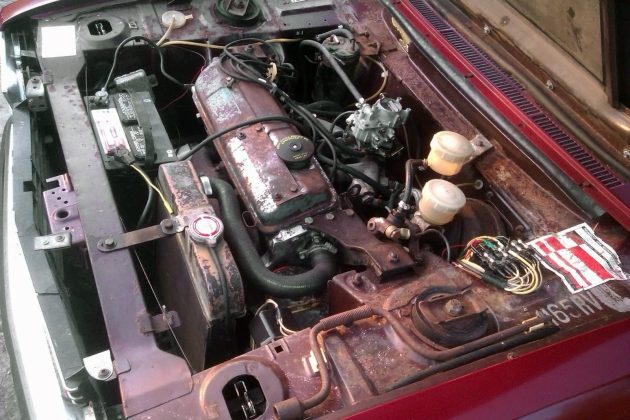Oui! This is a 1971 Peugeot 304 Wagon and it’s in Colton, Oregon. This French beauty is listed on eBay with a current bid price of just over $1,500 and the reserve isn’t met. This one is too nice to sell for $1,600 so, for you French car lovers, keep those bids coming.
If you’re like me, and hopefully for your family’s sake you aren’t, than a car like this really twerks your gibble. This car is nice, really nice, but it does have a couple of issues. There is a bit of rust that you’ll have to deal with, especially under the rubber floor mats, and the owner mentions that the original air cleaner assembly is missing as is a little piece of trim and the panel on the inside of the rear hatch. But, isn’t this a fun little car?! Who’s with me on that? Anyone?
The Peugeot 304 had a pretty long run, from 1969 to 1980. The wagon was actually called a “Break”, which for obvious reasons.. yeah. “Estate” was a much better term, and of course here in the US we call them wagons.
The interior looks fantastic in this car, but remember that the seller mentioned that there is a bit of rust in the floors, so that’ll have to be fixed. But, upholstery-wise, it looks great, front and rear. There isn’t a photo of the missing rear hatch panel, but other than that it looks great back there.
This is Peugeot’s 1.3L four-cylinder with around 65 hp. And, with the four-speed that may be enough for tooling down country roads in style, or at least having fun going on a picnic or showing up at a car show or two and seeing a few heads turn. I guarantee that this car would draw a crowd. The transmission shared oil with the engine which is unusual. I’ve never owned a French car, but seeing this one has caused me to add one to my master wish list. Have any of you ever owned a Peugeot 304 Wagon, or any French vehicles?







I really like french cars, as long as I don’t own one.
The most bizarre French car of all, perhaps, was the 2CV (deux chevaux). Many people know the vehicle, but not its raison d’être. Why would anyone build a 2-horsepower car? Tax! French cars were then taxed by engine size. Citroen was private; the competition, Renault, was government owned. The government lost little time in amending the vehicle taxation laws, because the small Renault was being hugely undercut, the puchase tax being also based on engine size.
The fairly-tale end, of course is that the 2CV was a success even after the increase in price. It became a symbol of the anti-authoritarian (starting with the French government) movement. They were also very cheap to run. Hitch-hiking in France many decades ago, I got a ride in a 2CV baker’s van. We traveled at about 40 mph for about five hours.
I’m VERY curious about,
“The wagon was actually called a “Break””
Does this mean in official model literature? If so that would be the first ‘official’ use of the term I’ve heard outside the recent internet auto phenom.
I’m with you, Bobsmyuncle, I hadn’t heard that before, but according to Wiki: “Production of the saloon/sedan on the Sochaux assembly lines was discontinued during the summer of 1979, while the “Break” (estate) was produced until the spring of 1980.”
If you do an image search for Peugeot 304 Break you’ll see a page full of “wagons”.
https://i.wheelsage.org/image/format/picture/picture-gallery-full/p/peugeot/304_break/peugeot_304_break_1.jpeg
Problem is, Wiki is contributed to by ordinary car aficionados. So the current trend of using the word would be carried forward.
If this term was actually used by Peugeot (or any manufacturer) back in the day I’d love to know of it.
Scotty I just (possibly) put 2 and 2 together, are YOU the writer? And if so do I now understand you used the Wiki that you mentioned to source that info?
“Break” is a shortened term from the words “Shooting Break.” It is a term which originated in Great Britain and refers to an Estate station wagon used to transport hunters, their guns, and dogs. Thus many European station wagons were called Shooting Breaks.
Yes this has been covered again and again. However there is little to no consensus on the first use. And the fact is the origin is not universally agreed upon. I am excited that the BAT writer may be referring to an actual official contemporaneous use of the term.
“Break” is short for “shooting brake,” so called because people who killed animals for fun would shoot pheasants (and, occasionally, peasants), for example, and put them in the back. A traditional shooting brake had strips of wood, at least — sometimes more wood than that, at the back. The name “station wagon” suggests a vehicle designed to hold luggage, just as shooting brake suggests a relevance to shooting.
My fee for that wisdom is three and sixpence.
Tony, There is no historical record of hunters shooting peasants, and throwing them in the back of a shooting brake. I’ll give you one and twopence for being half right.
I had a Peugeot 407S 3 liter and I think it is one of the most beautiful cars around. I always said its nose reminded me of the Ferrari 275 GTB I’ve dreamed of owning one day – in fact I’d maybe even buy a Peugeot 407 again for that reason alone.
I really like the peugeot 406 that was designed by pininfarina. Pininfarina also designs for ferrari so your guess is not far off.
My very first car was a ’59 403 Peugeot sedan.Cost me $300 in 1963 and it was a very nice car. My Dad liked it so much he bought a new 403 wagon (break) and then a 404 wagon (break). Both were excellent cars except for rusting away due to road salt in winter.
My 403 had a dual tone horn,city and country, which could be played to sound like a police car from “Irma La Douce”.
I have a 203 that has a factory equipped city/country horn and the previous owner [2 owner car] added a “GET THE HELL OUT OF MY WAY HORN”. It’s an air horn, and you won’t wonder if you’ve been honked at.
Looks like to me there was a roof luggage rack on this car at one time. Did the seller just happen to forget to mention that it is missing? If it is missing what would you do with the raised mounting holes in the roof? Just makes me wonder what else is missing or lack of information on the car. Good looking car. I like it a lot.
Good eye, that would be a concern.
I had a 1960 403 with a bad starter. Good thing it had a hand crank.
Why did Peugeot spell it “break” when the rest of Europe spelled it “brake”?
This thing is too cool, would love to be driving this around
I was 16 and in 1969 my dad bought a ’68 404, battleship grey, 4 speed on the column and a pretty rare model with mechanical fuel injection. That car was a beast! I can remember racing my buddy in his dads dodge polara on the Queensway at over 100 mph, he later said he could have gone faster but “the dodge was bouncing all over the place”. That Peugeot made many high speed trips to Toronto and Montreal.
Still a GTAer?
The raised fittings on the roof are standard and came with all the Peugeots of the era. They are made from bronze with an 8mm thread in the top to directly screw in the optional factory rack. I have a pair of four that were spare, left in the boot by someone on the factory line when we bought or 404 in 1970. We kept it for about 25 years.
The 404 (as well as 403 and 203) had a bronze worm drive differential. A mistake made by unknowing mechanics was to use EP diff oil which contains sulphur which ate away the bronze. I used a non-sulphur industrial oil meant for industrial worm drive reduction gear boxes.
Those models had wet cylinder liners and a ‘hotchkiss’ with a torque tube from the differential to the back of the gearbox with only one universal joint. The carb bolted direct to the cylinder head and all the manifolding was cast inside the head with large bore holes & tubes which is probably why the engine worked well at high revs.
Many of the mechanical parts were common between models and electricals between French car makers. As such, even today parts are not had to obtain, only rim items more difficult.
Sorry about the typos above, my wife wanted me to get off the computer.
Thanks for all of the great info, Peter!
My Rolls-Royce and Aston Martin station wagons were called”Shooting Brakes”- who through in this word – “Break” and why??
My friends family had a 304 just like this one in the mid to late 1970’s. Same color too. It was a great little car, handled really well, and was reliable, but it literally disintegrated from the rust. When it was finally done, it still ran well, but there was almost no front or rear fenders left at all. We tore it apart one day, pulling the motor out with my 442. Literally. Oh to be 16 again!
I had Peugeot 504 sedans in the mid 70s. They had some cool features and were comfortable and roomy. Slant 4 cylinder Hemi head engines, 4 speed column shift manual transmission (one of them), fully independent suspended rear drive axle.
Unfortunately, they had crappy French plastic and vinyl interior stuff and parts were difficult to find.
Mike
Mike, the sedans had the rear independent suspension. However, the wagons had a massive solid rear end. The rear wheel axles were huge and they used 6308 bearings as I recall. All that for a 90 to 100bhp engine. They also had a neat coil spring set up with four coils (two per side). There was a light weight one for driving with light loads and as the weight increased the second coil would take up the load. The coils were not inside each other but one for & aft of the axle tube. The diff housing and axle tubes were aluminium to save weight. Some of the wagons had a seven-seat option and this is where the four coils would have helped support the load. There were also some raised roof versions used as ambulances.
Where is this car now ? I’m in New York and I see one parked down the road from me on Broadway in Riverdale , with Oregon plates ! Is this the same car ? looks just like the one in the picture . I’m Mike (914) 964-9649
I had one of these a white 304 wagon, which while only 10 yrs old when I bought it had apparently lived a hard life and was neglected for some time. The turn signals didn’t work-that turned out to be corrosion on the fuses which were in an open box under the hood near the driver (like Fiats of the era). A little exercise and contact cleaner took care of that. The synchronizer for 2nd gear was broken so shifting into 2nd was difficult – sometimes I’d just skip 2nd. I was already pretty good at shifting a manual without using the clutch so I didn’t have a lot of trouble with that.
The hatchback had been kludged with a locking support to hold it open because whatever was there before presumably had failed.
It developed a severe leak at the water pump gasket. I was traveling 50 miles each way between jobs every day and would fill two jugs with water and stop every 10 or 20 miles to empty the jugs into the radiator and refill, until I spent the night at the 2nd job utilizing their brightly lit parking lot to do the repair. Finished up around 4am, took a nap in the wagon, drove back home to job 1.
I believe this was a fuel injected model.
It developed a miss somewhere along the way that the local Peugeot shop could never fix. We had a wreck with our other car and had been planning a trip to Vermont (from SE PA). The only car left was the 304.
Somehow the miss magically disappeared for the duration of the trip. As soon as the other car was back from the shop, the miss came back! Still this made it the only car I’ve ever encountered which ROSE to the occasion instead of the usual opposite.